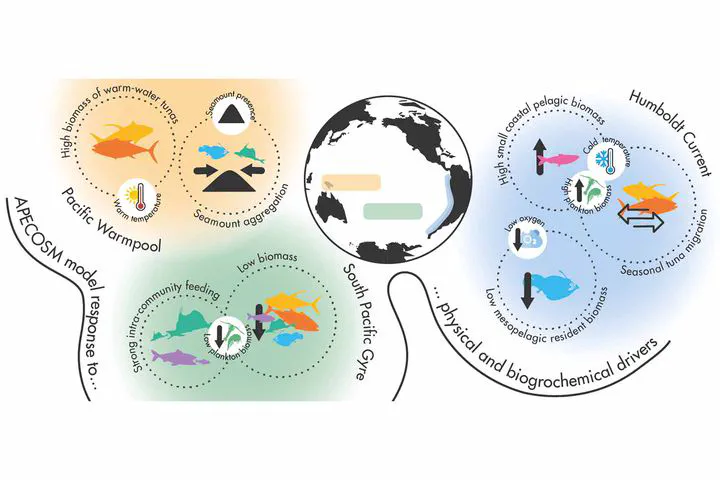Under review : How contrasted environments in the Humboldt Current System, Pacific Warm Pool and South Pacific Gyre, shape contrasted ecosystems. A modeling approach using APECOSM.
Sep 7, 2025· ,,,·
1 min read
,,,·
1 min read
Laureline Dalaut
Nicolas Barrier
Matthieu Lengaigne
Olivier Maury

Abstract
Pelagic ecosystems exhibit a strong regional heterogeneity, driven by physical and biogeochemical characteristics. Using the global 3D marine ecosystem model APECOSM, we simulate six high-trophic-level communities, capturing their size structure, spatial distribution, and trophic interactions up to 1,000 meters depth. We examine how different environments shape their contrasting organisation and interactions in three Pacific Ocean regions: the productive Humboldt Current System, the oligotrophic South Pacific Gyre, and the thermally stratified Pacific Warm Pool.
Simulations reveal strong regional contrasts in ecosystem responses. In the Humboldt, high primary production supports important biomass of small coastal pelagic fish. Seasonal warming enables tuna to forage in these productive waters, while low-oxygen conditions restrict the vertical range and abundance of mesopelagic organisms and concentrate epipelagic organisms close to the surface. In the Warm Pool, apex predators remain abundant despite low primary production, thanks to efficient trophic transfer and biomass import from neighbouring regions. Seamounts concentrate mesopelagic organisms into shallow layers, making them accessible to epipelagic predators. In contrast, the South Pacific Gyre supports sparse, imported high-trophic-levels with limited trophic coupling and strong intra-community predation. We quantify regional differences in trophic transfer efficiency and network complexity, identifying thresholds below which high-trophic-levels collapse.
These findings illustrate the emergent plasticity of pelagic ecosystems and the importance of bottom-up control of high-trophic-level biomass. They emphasise the importance of temperature, transport, light and oxygen in modulating horizontal and vertical distributions, controlling the co-occurrence of predators and prey, and influencing the formation of schools, ultimately impacting trophic interactions and community assemblages.
Type
This work is driven by the results in my previous paper on Progress In Oceanography.